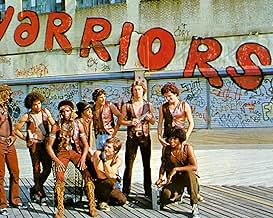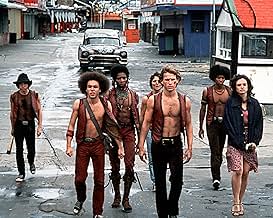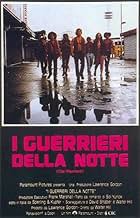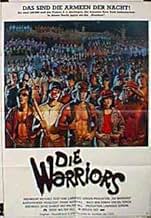En un futuro cercano, un carismático líder convoca a las bandas callejeras de la ciudad de Nueva York con la intención de tomar el control. Cuando es asesinado, los Warriors son falsamente a... Leer todoEn un futuro cercano, un carismático líder convoca a las bandas callejeras de la ciudad de Nueva York con la intención de tomar el control. Cuando es asesinado, los Warriors son falsamente acusados y deben luchar para volver a casa.En un futuro cercano, un carismático líder convoca a las bandas callejeras de la ciudad de Nueva York con la intención de tomar el control. Cuando es asesinado, los Warriors son falsamente acusados y deben luchar para volver a casa.
- Dirección
- Guionistas
- Elenco
Marcelino Sánchez
- Rembrandt
- (as Marcelino Sanchez)
- Dirección
- Guionistas
- Todo el elenco y el equipo
- Producción, taquilla y más en IMDbPro
Opiniones destacadas
There are numerous reasons why Walter Hill's THE WARRIORS remains a classic film - and arguably not simply a cult classic, but a true classic - despite its very much of-its-time sensibilities. Somewhat ironically, the movie's acting is not among those reasons. With the exception of two bravura efforts by Roger Hill and David Patrick Kelly, one will not find "command performances" here (although James Remar and Deborah Van Valkenburgh do gnaw quite a bit on the scenery). Other than that, the acting is hard-boiled and generic. But then, the lack of flair in the acting department is arguably one of the film's unsung strengths. As the main protagonist, for example, Michael Beck, while not exactly sympathetic, is an easily relatable hero. He's very much like Henry Fonda in 12 ANGRY MEN - except, of course, for the long hair and the bare chest.
Much more remarkable are all the ways in which THE WARRIORS managed to create a thrilling cinematic experience that still holds up today, despite its low budget. The list is a long one: set design (such as it is), dialogue, music, costume design, makeup, thematic elements. But most worthy of mention is Andrew Laszlo's cinematography. I love the camera's aesthetic, which is very "1970s" but, in a number of ways, is more compelling than any filmic style you'll see today. It is rooted in realism, but the "reality" it depicts is clearly a "heightened" variety, as we see the dark New York City streets illuminated as if by nighttime stage lights. And the outlandish goings-on seen throughout much of the film compound the surreal atmosphere. The end result is wonderfully paradoxical: it is an awe-inspiring experience to imagine that the fantastical events depicted could actually be happening, or once did happen.
But the "look" of this film would be insignificant without a strong story and solid thematic content, and THE WARRIORS possesses these in spades. It is remembered, somewhat condescendingly, as a "typical" late '70s film, but I think it is more accurate to think of it as a '60s film made a full decade too late. It is, after all, adapted from Sol Yurick's 1965 novel of the same name (and its tagline, "These are the armies of the night," obviously echoes the title of Norman Mailer's 1968 novel). More to the point, the movie's premise of a gangland insurrection contains quite a few overtones and undertones of political radicalism, and visual reminders of the '60s counterculture are not uncommon. (It is interesting to note that the original novel was inspired in part by Xenophon's 4th century B. C. epic ANABASIS, so the film also offers allusions to Greek myth and legend for those who care to look for them.)
But there is so much more in THE WARRIORS to capture the imagination. The movie's soundtrack - an assortment of disco, hard rock, and early synthpop, plus a few would-be radio hits - is rightly famous, as is its carnivalesque depiction of inner-city life (an influence on the Insane Clown Posse's "Dark Carnival" mythology, perhaps?). The action sequences, too, are first-rate - intense and thrilling. (Given that the cops who are looking for the Warriors are no less silently menacing than the rival gang members out for revenge, the mood of suspense is non-stop.) And few films have captured the frustration and tedium of making one's way through New York City's countless neighborhoods more effectively than this one.
It is unfortunate that THE WARRIORS will probably never be taken completely seriously by film critics and historians, in part because of the campy 2005 video game adaptation released in its "honor" (which I have played, and which is undeniably addictive and a hell of a lot of fun). But all those who are able to peer beyond the lens of the "cult" prejudice will be able to appreciate both Walter Hill's cinematic genius and his penchant for visual pizazz. From the opening image of a lit-up Ferris wheel - both innocent and eerie - to the final shot of a carefree romp along Coney Island's beach, THE WARRIORS is unforgettable.
Much more remarkable are all the ways in which THE WARRIORS managed to create a thrilling cinematic experience that still holds up today, despite its low budget. The list is a long one: set design (such as it is), dialogue, music, costume design, makeup, thematic elements. But most worthy of mention is Andrew Laszlo's cinematography. I love the camera's aesthetic, which is very "1970s" but, in a number of ways, is more compelling than any filmic style you'll see today. It is rooted in realism, but the "reality" it depicts is clearly a "heightened" variety, as we see the dark New York City streets illuminated as if by nighttime stage lights. And the outlandish goings-on seen throughout much of the film compound the surreal atmosphere. The end result is wonderfully paradoxical: it is an awe-inspiring experience to imagine that the fantastical events depicted could actually be happening, or once did happen.
But the "look" of this film would be insignificant without a strong story and solid thematic content, and THE WARRIORS possesses these in spades. It is remembered, somewhat condescendingly, as a "typical" late '70s film, but I think it is more accurate to think of it as a '60s film made a full decade too late. It is, after all, adapted from Sol Yurick's 1965 novel of the same name (and its tagline, "These are the armies of the night," obviously echoes the title of Norman Mailer's 1968 novel). More to the point, the movie's premise of a gangland insurrection contains quite a few overtones and undertones of political radicalism, and visual reminders of the '60s counterculture are not uncommon. (It is interesting to note that the original novel was inspired in part by Xenophon's 4th century B. C. epic ANABASIS, so the film also offers allusions to Greek myth and legend for those who care to look for them.)
But there is so much more in THE WARRIORS to capture the imagination. The movie's soundtrack - an assortment of disco, hard rock, and early synthpop, plus a few would-be radio hits - is rightly famous, as is its carnivalesque depiction of inner-city life (an influence on the Insane Clown Posse's "Dark Carnival" mythology, perhaps?). The action sequences, too, are first-rate - intense and thrilling. (Given that the cops who are looking for the Warriors are no less silently menacing than the rival gang members out for revenge, the mood of suspense is non-stop.) And few films have captured the frustration and tedium of making one's way through New York City's countless neighborhoods more effectively than this one.
It is unfortunate that THE WARRIORS will probably never be taken completely seriously by film critics and historians, in part because of the campy 2005 video game adaptation released in its "honor" (which I have played, and which is undeniably addictive and a hell of a lot of fun). But all those who are able to peer beyond the lens of the "cult" prejudice will be able to appreciate both Walter Hill's cinematic genius and his penchant for visual pizazz. From the opening image of a lit-up Ferris wheel - both innocent and eerie - to the final shot of a carefree romp along Coney Island's beach, THE WARRIORS is unforgettable.
I was working in a movie theater when The Warriors first came out, and remember well the flick and the hype surrounding it. Here's a few notes to clear up some misconceptions that many other commentors seem to have.
The flick was NOT ever intended to be an accurate portrayal of New York gang life, although there were some realistic elements. At the time it was generally accepted that it took place in the future, although nothing in the movie supports this. At best it can be considered an urban fable that takes place in a sort-of-imaginary world. You know, like Pulp Fiction (you think 90s LA gangsters dressed like that??).
Second, the film itself was not accused of inciting violence. Problem was, it was a VERY popular film with gang members, who would show up in force. Two rival gangs would show up at the same theater, and... you can figure the rest out yourself. One guy was killed on the first weekend the movie was playing in New York; after that, the distributor hired off-duty police for security at every theater across the country that showed the flick. In the small-town Midwest where I lived, this served more as advertising hype than anything else.
Finally, it was widely known back in the day that The Warriors was based on the ancient Greek nonfiction tale Anabasis, written around 370 BC by the Spartan general Xenophon (it's also published under the title The Persian Expedition). In this classic tale, a battalion of 10,000 Spartan mercenaries join the Persian emperor Cyrus for a war in Asia Minor (i.e. Turkey). Cyrus's army is defeated, the Spartan leaders are captured, and the remaining force must make their way across country, fighting various hostile tribes along the way, experiencing their own internal power struggles, until they reach the safety of the sea. I'm shocked that only one reviewer seemed to be familiar with this; in the 70s almost nobody talked about the movie without mentioning it.
Great flick, by the way, and it holds up extremely well over time. I'm sure the remake will suck.
The flick was NOT ever intended to be an accurate portrayal of New York gang life, although there were some realistic elements. At the time it was generally accepted that it took place in the future, although nothing in the movie supports this. At best it can be considered an urban fable that takes place in a sort-of-imaginary world. You know, like Pulp Fiction (you think 90s LA gangsters dressed like that??).
Second, the film itself was not accused of inciting violence. Problem was, it was a VERY popular film with gang members, who would show up in force. Two rival gangs would show up at the same theater, and... you can figure the rest out yourself. One guy was killed on the first weekend the movie was playing in New York; after that, the distributor hired off-duty police for security at every theater across the country that showed the flick. In the small-town Midwest where I lived, this served more as advertising hype than anything else.
Finally, it was widely known back in the day that The Warriors was based on the ancient Greek nonfiction tale Anabasis, written around 370 BC by the Spartan general Xenophon (it's also published under the title The Persian Expedition). In this classic tale, a battalion of 10,000 Spartan mercenaries join the Persian emperor Cyrus for a war in Asia Minor (i.e. Turkey). Cyrus's army is defeated, the Spartan leaders are captured, and the remaining force must make their way across country, fighting various hostile tribes along the way, experiencing their own internal power struggles, until they reach the safety of the sea. I'm shocked that only one reviewer seemed to be familiar with this; in the 70s almost nobody talked about the movie without mentioning it.
Great flick, by the way, and it holds up extremely well over time. I'm sure the remake will suck.
During a gang summit in the Bronx, a rival gang leader (Roger Hill) is shot and killed. A Coney Island gang is wrongfully accused of the crime and find themselves on the run from other gangs and cops as they race back to their turf. Will they make it back in one piece?
Walter Hill's ("48 Hrs.") stylish tale about gang warfare packs a punch (even by today's standards). Upon release, the film sparked controversy and was accused of encouraging gang violence. After one look, it's not brutal, graphic or unpleasant. It's an exciting, fast-paced, action-packed, non-bloody tale that sends a message with conviction. Most of the gangs portrayed are too cartoonish to be menacing, but yet they are unique in more ways than one. Credit should also be given to Andrew Laszlo's photography. A cult classic. "Can you dig it?"
My evaluation: *** out of ****.
Walter Hill's ("48 Hrs.") stylish tale about gang warfare packs a punch (even by today's standards). Upon release, the film sparked controversy and was accused of encouraging gang violence. After one look, it's not brutal, graphic or unpleasant. It's an exciting, fast-paced, action-packed, non-bloody tale that sends a message with conviction. Most of the gangs portrayed are too cartoonish to be menacing, but yet they are unique in more ways than one. Credit should also be given to Andrew Laszlo's photography. A cult classic. "Can you dig it?"
My evaluation: *** out of ****.
Just a couple of points to add to the general accolades above:
Here in England the BBC have twice shown a version of The Warriors with a prologue scene, edited from the released movie but restored to a point prior to the opening 'Wonder Wheel' shot. It shows Cleon (an otherwise very underused character), sitting on the Boardwalk in the late afternoon sunshine waiting for his eight footsoldiers to show, while his girlfriend pleads with him not to go to the Bronx. When the others arrive and line up he designates their roles, including the "Swan: War chief and second in command" alluded to later in the movie. Ajax gives an early sign of his belligerent nature, voicing his disapproval with bringing a boombox-guy and a graffiti-artist: "They'll only slow us down", but seems happy to be labelled as "Heavy Muscle" along with Cochise. Much of the dialogue from this scene is re-used in the credit-sequence, with the shots of Coney and the gathering forces intercut with short interchange between Warriors. However, the prologue scene ends unforgettably with a crane-shot of the nine striding up the Boardwalk and into the distance, casting long shadows on the decking and with Cleon's girlfriend trailing in their wake. Over this, a slow sixties surf-tune booms out as the waves wash against the shore. Bloody wonderful.
Unfortunately I have never found a store-bought version which includes this material - DVD community, do you know?
Another thing I heard was that the original idea was that the movie was set "Sometime In The Near Future", but Walter Hill dropped the idea of having a caption stating as much at the start of the film. This explains some of the discrepancies with the actual New York gangland, being more about delinquent youth and 'Colours' than Organised Crime syndicates and shiny suits.
Third - a fantastic action movie full of colour, vim and attitude, but which also never fails to break my heart every time I watch it. There are a couple of scenes like this - mostly Deborah Van Valkenburgh's - but the main one is with Swan and Mercy on the Subway as the High School 'Preppies' complete with ruffled shirts and massive lapels sit down opposite, their laughter and smiles soon fading as the contrast becomes blindingly obvious to them as well as us. Walter Hill plays this scene perfectly: with no dialogue as such, and with Swan and Mercy not even looking at each other as he takes her hand from her hair and places it firmly by her side. Och, goosebumps even thinking about it!
Finally, having also read the original 'Anabasis' (I had to) when I was studying Ancient Civilisations of the Med at University, as a piece of pure drama The Warriors could shove a bat up it's ass and turn it into a Popsicle. Can You Dig It?!
Here in England the BBC have twice shown a version of The Warriors with a prologue scene, edited from the released movie but restored to a point prior to the opening 'Wonder Wheel' shot. It shows Cleon (an otherwise very underused character), sitting on the Boardwalk in the late afternoon sunshine waiting for his eight footsoldiers to show, while his girlfriend pleads with him not to go to the Bronx. When the others arrive and line up he designates their roles, including the "Swan: War chief and second in command" alluded to later in the movie. Ajax gives an early sign of his belligerent nature, voicing his disapproval with bringing a boombox-guy and a graffiti-artist: "They'll only slow us down", but seems happy to be labelled as "Heavy Muscle" along with Cochise. Much of the dialogue from this scene is re-used in the credit-sequence, with the shots of Coney and the gathering forces intercut with short interchange between Warriors. However, the prologue scene ends unforgettably with a crane-shot of the nine striding up the Boardwalk and into the distance, casting long shadows on the decking and with Cleon's girlfriend trailing in their wake. Over this, a slow sixties surf-tune booms out as the waves wash against the shore. Bloody wonderful.
Unfortunately I have never found a store-bought version which includes this material - DVD community, do you know?
Another thing I heard was that the original idea was that the movie was set "Sometime In The Near Future", but Walter Hill dropped the idea of having a caption stating as much at the start of the film. This explains some of the discrepancies with the actual New York gangland, being more about delinquent youth and 'Colours' than Organised Crime syndicates and shiny suits.
Third - a fantastic action movie full of colour, vim and attitude, but which also never fails to break my heart every time I watch it. There are a couple of scenes like this - mostly Deborah Van Valkenburgh's - but the main one is with Swan and Mercy on the Subway as the High School 'Preppies' complete with ruffled shirts and massive lapels sit down opposite, their laughter and smiles soon fading as the contrast becomes blindingly obvious to them as well as us. Walter Hill plays this scene perfectly: with no dialogue as such, and with Swan and Mercy not even looking at each other as he takes her hand from her hair and places it firmly by her side. Och, goosebumps even thinking about it!
Finally, having also read the original 'Anabasis' (I had to) when I was studying Ancient Civilisations of the Med at University, as a piece of pure drama The Warriors could shove a bat up it's ass and turn it into a Popsicle. Can You Dig It?!
"Listen boppers", this is a great gang flick that has a small crew chased down by every gang in NYC after they are wrongly accused of killing Cyrus (the local crime boss) at the Bronx Zoo. The Warriors have to make it from the Upper Bronx to Coney Island with every gang in town trying their own unique ways of knocking them off. Baseball mimes, Roller Skating posses, chick gangs, and of course, the "Riffs" do their darnedest to knock off the resilient Coney Island gang before they can make it back to their stomping ground. A local radio announcer (the woman from "Where in the World is Carmen San Deigo?") narrates their progress downtown, tipping off rivals and setting up further confrontation. A great movies for all ages.
¿Sabías que…?
- TriviaSol Yurick wrote the original book as a rebuttal to the romanticized view of street gangs presented in Amor sin barreras (1961) based on his experience as a New York City welfare department worker.
- ErroresWhen the Warriors first leave the gunfight in the Bronx, we see them walking in the rain, completely soaked. A short while later, they're back on the train with dry hair and clothes.
- Créditos curiososIn the original version, the end credits are followed by 3 minutes of black screen as the Joe Walsh song "In the City" plays.
- Versiones alternativasThe Ultimate Director's Cut runs around one minute longer, adding a voiceover introduction from director Walter Hill describing a legendary Greek army's attempt to fight its way home, and comic-book freeze frame shots bridging various scenes in the film.
Selecciones populares
Inicia sesión para calificar y agrega a la lista de videos para obtener recomendaciones personalizadas
Detalles
Taquilla
- Presupuesto
- USD 4,000,000 (estimado)
- Total en EE. UU. y Canadá
- USD 22,490,039
- Fin de semana de estreno en EE. UU. y Canadá
- USD 3,529,675
- 11 feb 1979
- Total a nivel mundial
- USD 22,495,685
Contribuir a esta página
Sugiere una edición o agrega el contenido que falta




































